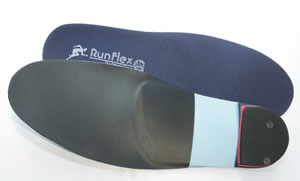Biomechanics and Orthotics
Many foot problems occur because of abnormal biomechanical function of the feet during the walking cycle. The foot is composed of 26 bones and numerous articulations, ligaments, tendons and muscles. The way the bones, muscles and tendons interact with each other determines how the foot functions and the stresses and strains placed on the body as a whole. The following can also contribute to imbalance in the feet:
Orthotics Orthotics (a type of insole which is worn inside your normal shoes) can be used to treat biomechanical abnormalities in the feet by improving foot function during gait.Even the slightest misalignment or abnormality can result in significant discomfort and can lead to:
I make a detailed biomechanical examination of the feet to determine what the problem is. Computerised Gait AnalysisI use the TOG GaitScan (The Orthotic Group) equipment as a diagnostic tool to provide assessment and diagnosis of foot biomechanics.
Further information about orthotics
|
|
| Sue Ferguson BSc (Hons), MRCPod Chiropodist and Podiatrist 2 St Benets Court Tenterden Kent TN30 6QS Tel: 01580 765546 Email: sjf.ferguson@gmail.com |
